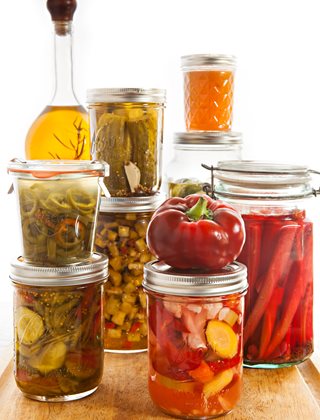Lansing’s Jams and Pickled Vegetables
Travel writer and edible gardener David Lansing shares recipes for jams and pickled vegetables.At harvesttime, there sometimes is too much of a good thing. So Lansing has collected a long list of ways to use his wide variety of plants. Here, he shares four recipes.
I like to use purple carrots which are much higher in nutrients than orange carrots, but whatever you have on hand is fine. Baby carrots are particularly attractive and make a great appetizer. If you use large carrots, they should be halved or quartered so no spear is wider than ½ inch.
Makes 1 quart
Ingredients
- 1½ cups water
- 1 cup apple cider vinegar
- ¼ cup sugar
- 1½ Tbsp kosher or pickling salt
- 2 tsp coriander seeds
- 2 tsp cumin seeds
- 1 lb baby or medium-sized carrots, peeled and trimmed
- Peel of 1 lemon or, even better, skin from 1 preserved lemon, rinsed
- 5 to 6 medium garlic cloves, peeled and thinly sliced
- 4 small dried hot red chiles (like Thai or chiles de arbol), halved
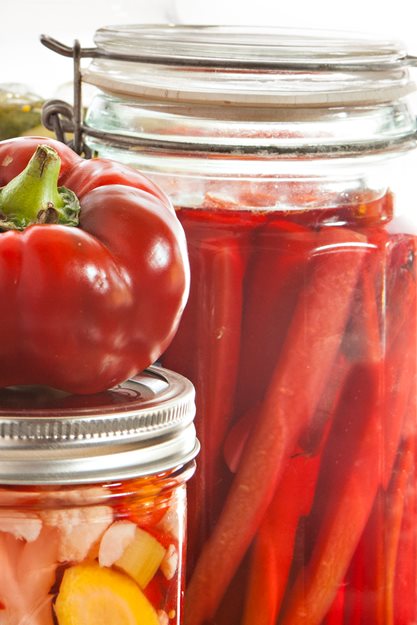
Pickled Turkish carrots.
Photo by: Bret Gum.
Instructions
- Mix water, vinegar, sugar, salt, coriander, and cumin in medium saucepan.
- Bring to boil and stir until sugar and salt dissolve, about 3 minutes.
- Remove from heat.
- Pack carrots vertically into a 1-quart jar. If using spears, cut tops or bottoms to fit.
- Add lemon peel, garlic, and chiles.
- Pour hot brine over carrots and let sit at room temperature for 1 to 2 hours.
- Refrigerate. Carrots develop more flavor with time.
This is an adaptation of a recipe by David Chang of Momofuku. The thinness of the beets and their crunch make them as addictive as potato chips. Although it’s possible to slice them with a knife, they come out best if you use a mandoline.
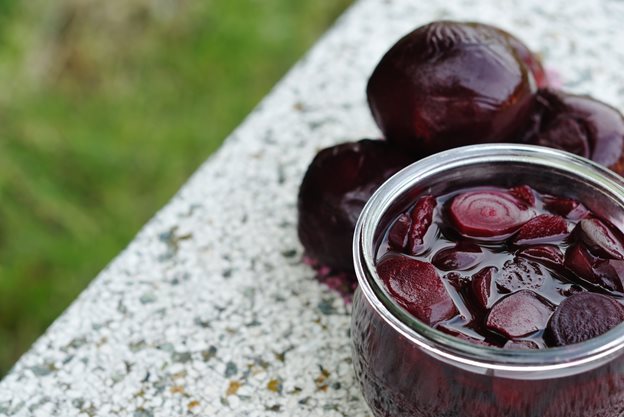
Raw pickled beets.
Makes 1 quart
Ingredients
- 1 lb medium beets, trimmed, peeled, and sliced paper thin
- 1 4- by-4-inch piece of kombu (form of seaweed found in Japanese markets)
- 1 cup unseasoned rice vinegar
- 1 cup granulated sugar
- 1 cup water
- 2 Tbsp kosher or pickling salt
- Pack the beets and kombu tightly in a 1-quart jar, leaving at least ½ inch of room at the top of the jar.
- For the brine, place the vinegar, water, sugar, and salt in a saucepan; whisk to dissolve the sugar and salt and bring to a rapid simmer for 2 minutes.
- Pour the hot brine over the packed beets, making sure to cover them completely but leaving ¼ inch of room at the top.
- Let cool, uncovered, at room temperature for 1 to 2 hours. Cover and refrigerate for at least one day, preferably one week, before using.
This is an adaptation of the house pickles served at Gjelina in Venice, California. I always have a jar of these sitting in the fridge and usually just top it up from time to time with fresh sliced cukes, keeping the same brine. These are like spicy bread-and-butter pickles and go well with just about everything. Using a mandoline makes this an easy recipe.
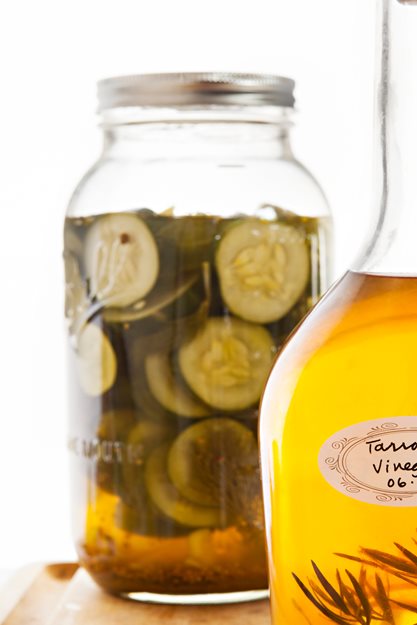
Spicy sweet cucumber pickles.
Photo by: Bret Gum.
Makes 2 quarts
Ingredients
- 1 Tbsp mustard seeds
- 1 Tbsp coriander seeds
- 1 ½ tsp dill seeds
- 2 cups water
- 1 cup white wine vinegar
- ¼ cup sugar, rounded
- 2 Tbsp kosher or pickling salt
- ¼ tsp ground turmeric
- ¼ tsp or more crushed red pepper flakes
- 1 pound Persian or pickling cucumbers, cut in to ½-inch thick rounds
- 2 to 3 dill sprigs
- 2 to 3 garlic cloves, thinly sliced
Instructions
- Make the brine by quickly toasting the mustard seeds, coriander seeds, and dill seeds in a dry saucepan over medium heat until fragrant (about 3 minutes).
- Add the water, vinegar, sugar, salt, turmeric, and red pepper flakes.
- Bring to a boil, lower the heat, and simmer for about 5 minutes.
- Remove from heat and let cool.
- In two 1-quart canning jars, layer the cucumber rounds, dill sprigs, and garlic slices.
- Add the cooled brine to the jars.
- Let sit at room temperature for 1 to 3 hours.
- Refrigerate.
I never process jam in boiling water: I think it dilutes both the fresh color and taste of good peaches. Instead, I use a trick I learned from Darina Allen at the Ballymaloe Cookery School: Preheat your jam jars and lids in the oven while you prepare your jam. This technique works for all fruit jams.
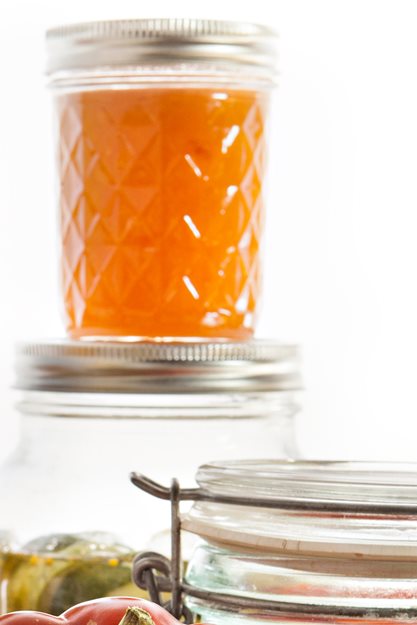
Simple peach jam.
Photo by: Bret Gum.
Makes about 4 half pints of jam
Ingredients
- About 2 lb peeled, pitted, crushed peaches (3+ cups)
- 3 Tbsp pectin
- 2 Tbsp bottled lemon juice (don’t use fresh, which has an inconsistent pH)
- 3 cups sugar
Instructions
- Place jam jars and lids on a baking sheet and place in oven preheated to 250 degrees. Heat jars for at least 30 minutes to properly sterilize.
- While jars and lids are in the oven, peel the peaches. The easiest way to peel peaches is to drop a few at a time in to a pot of boiling water for a minute or so, removing them with a slotted spoon into a bowl of ice water. The skins will slip right off.
- Coarsely chop the peeled and pitted peaches, then mash with a potato masher.
- Put in a heavy pot (preferably copper) and add pectin, lemon juice, and sugar.
- Slowly boil for about 25 minutes, stirring constantly to keep from burning, until the jam has a slight shine to it and does not easily run off a cold spoon.
- Ladle immediately in to hot jars, leaving ½ inch of headspace at the top. Screw on lids and place on cookie sheet back in the oven for 15 minutes.
- Remove from oven and let sit undisturbed on drying rack overnight. The jars will seal as they cool.
This bonus content accompanies “The Globetrotter’s Garden”—an article about how a travel writer’s garden is informed by his more than 30 years traipsing the globe—in the Spring 2017 issue of Garden Design magazine.
